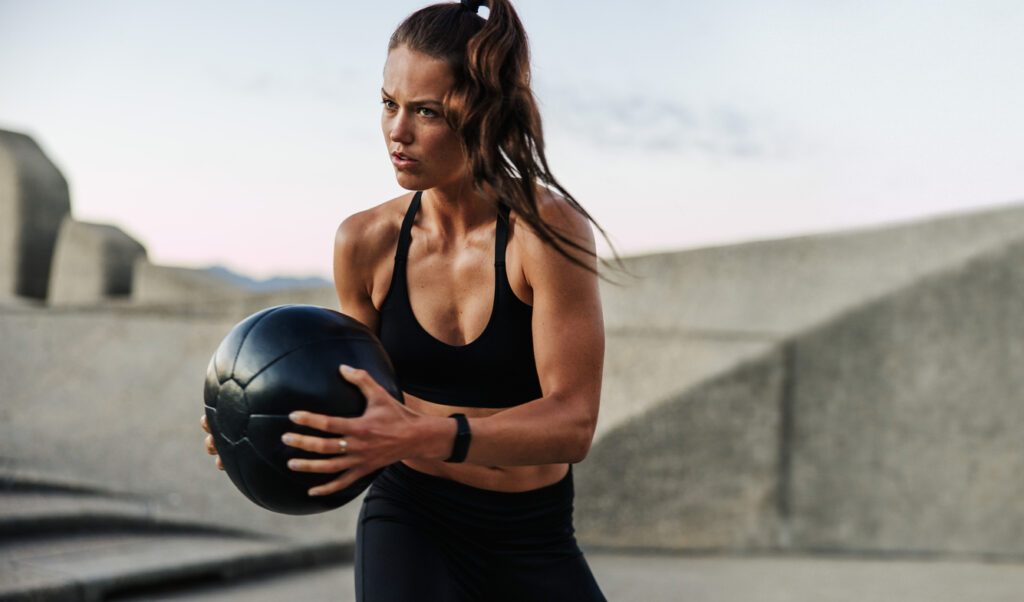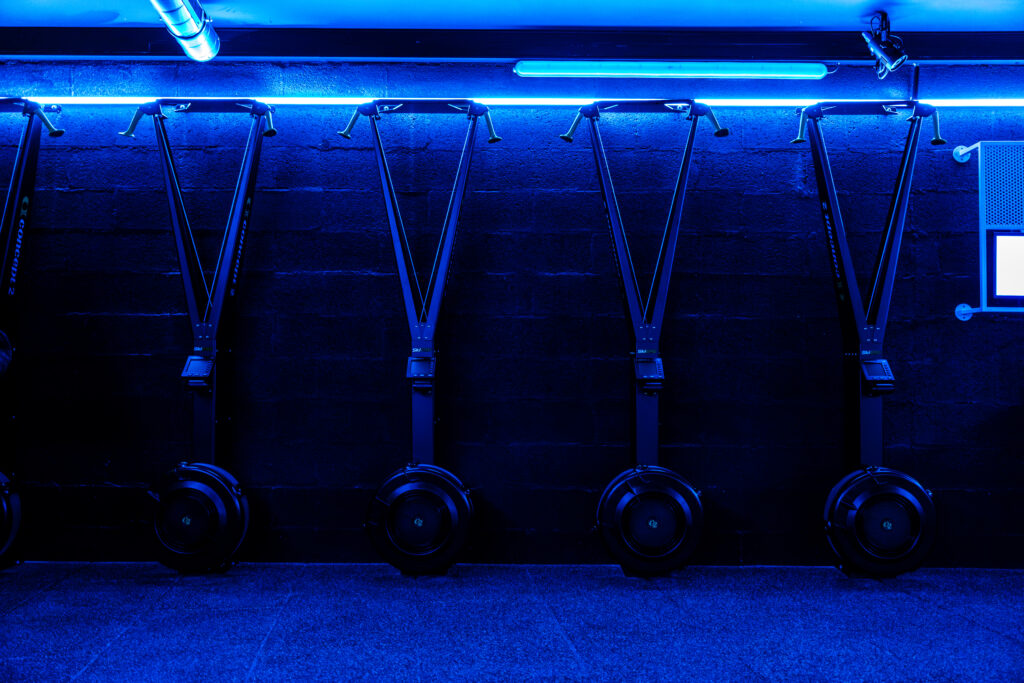
Summary
Welcome / Welcome / Tips for getting started / Cross training benefits: the advantages of this discipline
Cross training benefits: the advantages of this discipline
If you're looking for a training method that combines variety, efficiency And overall welfareCross training is probably just what you need. Perfect for users looking to improve their healthThis discipline encompasses a vast selection of exercises and sports disciplines, providing a multitude of benefits for both body and mind.
Cross training allows you toimprove your general physical condition, of strengthen your muscles, d'increase your cardiovascular enduranceThe variety of movements and equipment used makes it particularly attractive. What makes this activity particularly attractive is its accessible to all fitness levels and all ages, offering the perfect option for those looking to get fit in an engaging and motivating way.
In this article, we take a closer look at the the main benefits of cross training and the reasons why this training method has become a benchmark in the world of fitness.
Summary
What is cross training?
Definition and basic principles
THE cross trainingalso known as cross trainingis a multi-purpose training strategy which integrates various physical activities in order to develop a healthy, active lifestyle. complete physical fitness. This method aims to optimising athletic performance and promote excellent packaging by combining techniques from a wide range of sporting disciplines, making a real difference compared with single-discipline training.
This approach encourages different muscle groups and energy systems, helping to eliminate muscular imbalances and reduce the risk of injury. For example, a runner could add swimming or cycling to his training to maintain his cardiovascular endurance while taking care of his muscles and joints. Cross training is characterised by its diversity and intensityIt includes exercises in strength, power, endurance, flexibility, agility, coordination, speed and balance, all of which are essential for building a balanced and versatile physical condition.
The main benefits of cross training
Improving general physical condition
Cross training considerably improves physical condition by offering a variety of exercises that work on different qualities athletic. This method strengthens Muscular force, l'endurance, there flexibility, there coordination and thebalance. By mixing strength training, cardio and flexibility exercises, cross training offers a complete workout that targets every aspect of fitness. Its great effectiveness comes from its ability to prevent muscular imbalances by varying the exercises, which reduces the risk of injury and ensures that the body adapts better.
Weight loss and body sculpting
Cross-training is proving to be a powerful tool for the weightloss and the body sculpture. Thanks to its high-intensity sessions that combine strength and cardio, it stimulates the metabolism and encourages fat burning. Integrated muscle strengthening tones the body, encouraging a physical transformation marked by weight loss and a gain in muscular strength and definition. This holistic approach to exercise burns calories efficiently and maintains a high post-training metabolism, helping you to lose weight for good.
Injury prevention
One of the major advantages of cross training is its ability to prevent injuries. By diversifying activities, it avoids overtraining and reduces the risk of injury from repeating the same movements. It provides active rest for muscles that have been stressed by other activities, reducing muscle imbalances and improving joint mobility. This variety of exercises also strengthens the stabilising muscles, which are essential for good posture and preventing musculoskeletal injuries.
Mental and psychological benefits
The benefits of cross training also extend to mental wellbeing and psychological benefits. Physical activity, and cross-training in particular, promotes the release of endorphins, improving mood and reducing stress. These 'happy hormones' create a post-training sense of well-being, combating anxiety and depression. In addition, cross-training strengthens social ties and the sense of belonging to a community, which is vital for self-esteem and mental resilience. It encourages perseverance, team spirit and the desire to surpass oneself.
Structure of a typical cross-training session
Warming up
Each cross-training session begins with a thorough warm-upThis is essential to prepare the body for the intensity of the effort ahead. This warm-up phase, which lasts between 5 and 10 minutes, is designed toincrease body temperatureThe aim of the general warm-up is to improve circulation and activate the major muscle groups. The activities chosen for the general warm-up typically include light cardiovascular exercises such as running, rowing, cycling or skipping.
These activities serve to gradually raise the heart rate and stimulate blood circulation throughout the body. In addition, muscle mobilisation exercises such as air squats, push-ups, light burpees or kettlebell swings are incorporated to gently wake up the muscles. An example of a warm-up might be 2 minutes on the rowing machine, followed by 10 crabbed steps with a resistance band (five on each side), and 10 gluteal bridges.
This global approach effectively prepares the body for exercise and minimises the risk of injury by improving the elasticity of blood vessels and ensuring optimal oxygenation of muscles.
Body of the session
The heart of the cross training session is the most intense and varied part. It consists of two key elements: strength training and the Workout of the Day (WOD). Strength training includes muscle-strengthening exercises using either bodyweight or free weights, such as deadlifts, jump squats, thrusters, pull-ups and bench presses. These exercises aim to improve muscle strength and power.
The WOD is the main exercise of the session and changes daily. It can be a 30-minute endurance session, such as a run or rowing session, or a shorter but intensely dynamic session, including burpees, box jumps or mountain climbers. The WOD is specifically designed to test and improve a variety of abilities, including strength, endurance, agility and coordination.
Calming down and stretching
The back to calm is essential after the intensity of the session. It includes stretches designed to relax the muscles and increase flexibility. These stretches target the muscle groups most used during training, such as the quadriceps, hamstrings, back and glutes. A typical stretch for the quadriceps can be performed by holding an ankle with the corresponding hand and bringing the foot towards the buttocks, while for the hamstrings, it's performed by sitting on the floor, legs straight, and bending forward. These stretches help to prevent injuriesThese exercises help to reduce muscular pain and promote better recovery, as long as they are maintained for at least 30 seconds per muscle.
Cross training for different profiles
Suitable for beginners
THE cross training is for everyone, including beginners. For beginners, it's important to start with a limited range of exercises so that you can progress in a linear and safe way.
Initially, beginners don't need a wide variety of exercises. A limited selection reduces the risk of injury due to overtraining or inadequate technique. An experienced trainer can develop a customised training planThese include fundamental exercises such as squats, push-ups and skipping rope, as well as moderate cardio sessions. These activities strengthen muscles and gradually improve physical condition, while minimising the risk of injury.
What's more, beginners can take advantage of the community and the support offered by cross training, which can greatly motivate them and encourage them to persevere with their training.
Cross training for experienced athletes
For experienced athletes, cross-training is a chance to vary their training and prepare in a more complete way. They can incorporate cross-training activities specific to their main discipline to boost their performance and reduce the risk of injury. For example, runners can add elliptical or cycling sessions to their programme to maintain their cardiovascular endurance without overtaxing the joints and muscles involved in running.
Experienced sportsmen and women also benefit from the periodization of their training, by selecting a variety of cross-training activities according to the period of their sporting season. This allows them to maintain excellent physical condition all year round, avoiding stagnation and reducing the risk of injury.
Cross training after 40
After the age of 40, cross-training is particularly beneficial for maintaining and improving physical fitness. It's essential to continue exercising intensively, but in the right way, to counteract the effects of ageing. Cross training combines muscle strengthening, cardio and stretching, which are essential for maintaining muscle mass, bone density and flexibility.
Muscle-strengthening sessions with moderate to heavy weights, combined with split cardio, are key to preserving muscle and bone mass. Regular stretching is also vital for bodily well-being and injury prevention.
This complete training method ensures excellent physical fitness and enables you to continue practising sporting activities safely and effectively, even in later life.
Equipment and venues
Essential equipment for getting started
To get started in cross training, it's important to be properly equipped. This equipment is selected to guarantee secure practice And effective.
THE cross training shoes are fundamental. They provide the stability and support needed for a variety of movements, including running, weightlifting and gymnastics. Visit Nike Metcon are very popular for this type of activity.
A jumping rope is also essential for cardio and improving coordination. The Corength skipping rope is renowned for its excellent value for money. The addition of a floor matfor comfort and protection during exercises on the ground, and a drawbarto strengthen the upper body, is also recommended.
The use of potholders, kettlebells and other specific accessories enriches the cross-training experience. This equipment diversifies workouts and targets different muscle groups for a complete workout.
Practice indoors vs. at home
The choice of whether to practise cross-training indoors or at home varies according to personal preferences, objectives and financial resources.
In the gymAccess to professional equipment and a variety of specific training sessions is a major advantage. The motivating atmosphere and stimulating environment, in the company of other enthusiasts, can boost your motivation. Professional trainers can personalise your programme and monitor your progress, making this option cost-effective thanks to the reduced rates for group classes.
At homeFor those who prefer to avoid public places or who have a tight schedule, the comfort and privacy of the gym will appeal. Thanks to online videos and programmes, you have a great deal of flexibility in your training routine. It's important to be properly equipped and to follow safety instructions to avoid injury. Online coaching or fitness apps can help maintain motivation and follow a structured programme, although keeping discipline can be more difficult away from the atmosphere of a gym.
Nutrition and recovery to optimise benefits
Diet for cross training
A balanced nutrition is fundamental to maximising the benefits of cross training. Adapting your diet to the specific energy requirements of this discipline is essential to maintain optimum performance and encourage effective recovery.
Nutrition experts recommend giving priority to unprocessed food and high quality. The CrossFit philosophy sums up this approach well: "Eat meat and vegetables, nuts and seeds, a little fruit, few starches and no sugar". It's essential to adjust your diet to suit your training sessions, without contributing to an increase in body fat.
THE macronutrients play a vital role. Cross-training athletes need sufficient protein for muscle repair and construction. Carbohydrates are needed for energy during intensive training, while healthy fats support vital functions. Energy requirements can vary greatly, from 2,000 to 12,000 calories per day, depending on the intensity and frequency of training.
Particular attention should be paid to ensuring an adequate intake of micronutrientssuch as vitamins and minerals. Deficiencies in vitamin E, iron, calcium and folate are common among cross-trainers. A varied diet, rich in vegetables, fruit, pulses and wholegrain cereals, is key to making up for these deficiencies.
Effective recovery strategies
A adequate recovery is essential if you are to derive maximum benefit from cross training. It helps to repair muscles, restore energy and prevent injury. Adopting a training schedule that alternates between phases of high intensity and active recovery is fundamental.
Recovery phases should be carefully organised, including low-intensity activities such as walking, yoga or swimming, to encourage muscle repair and restore energy. Stretching and joint mobilisation exercises after each session are also essential.
These techniques help to limit muscle soreness and improve flexibility, which are essential for maintaining good mobility and avoiding injury. In addition, the timing of nutrient intake can play a role in recovery. Although research indicates that the precise timing is not decisive, a diet strategically planned around training sessions can promote better muscle recovery and efficient recharging of energy reserves.
Testimonials and concrete results
Physical transformations
The stories told by those who practise cross-training often reveal the following amazing physical transformations. Take the example of Sandrine, aged 34, who has dramatically increased her performance, going from 11 to 17 pull-ups and from 25 to 35 dips in just two months. Despite the challenges posed by her environment, she has managed to considerably improve your physical conditionShe has mastered exercises such as straight leg raises, which were previously out of her reach. Dorine, meanwhile, at the age of 50, has not only lost 5 kg and reduced her waistline by 4 cm, but has also significantly improved cardiovascular endurance. More than just a physical transformation, Dorine shows a clear improved self-confidence and general well-being. These stories highlight the ability of cross training to adapt to different ages and fitness levels, resulting in significant and lasting changes.
Performance improvements
L'improved performance is another pillar of the tangible benefits of cross training. Those who incorporate this discipline into their training frequently report significant advances in strength, endurance and overall performance. Studies show that cyclists who add running to their training can see an improvement in their bone density, muscular strength and endurance, as well as a better tolerance of effort. Runners who benefit from targeted muscle training can optimise their running economy, defined as the ratio between oxygen consumption and speed. Testimonials from CrossFit Louvre 2 in Bordeaux, such as those of Emma, who went from 2 to 3 strict pull-ups and from 5 to 10 seconds of plank, or Luana, who improved her flexibility and performance in street workout, illustrate perfectly the positive impact of cross-training on physical and mental capacities. These concrete examples show that cross-training is much more than a training method: it is a genuine lever for transforming and optimising athletic performance.
Conclusion
THE cross training is presented as a method holistic and diversified, designed to improve physical conditionprevent injuries and promote a healthy lifestyle. overall welfare. It skilfully blends aerobic, muscle-strengthening and flexibility exercises to engage all muscle groups, ensuring optimal fitness.
This practice brings many benefits benefits These include improved overall fitness, effective weight loss, muscle definition, reduced risk of injury, as well as mental and psychological benefits. To get started, it's essential to select the right equipment and follow a strict training programme. balanced diet.
You can make cross-training part of your daily routine both indoors and at homeA wide range of exercises and activities to break the routine and boost your motivation. It's time to take action!
Embrace cross training to revolutionise your life and achieve your fitness goals in the engaging and long-lasting. Thanks to its flexibility and countless benefits, cross-training is perfect for everyone, whatever your level or ambitions.
At DRIP, you'll find HIIT workouts as well as workouts designed to prepare you for an event. HYROX race in Paris studio.
FAQs
What are the advantages of Cross Training?
THE cross-training presents many advantages. It contributes to reduce the risk of injury thanks to the variety of exercises, avoiding wear and tear on the same muscle groups and joints.
It promotes improved physical condition including aerobic capacity, strength and flexibility. Cross-training makes it possible to continue training despite injury by substituting activities, reducing the boredom associated with repetitive training and boosts motivation.
What's more, it allows flexibility in planning training sessions and improves agility and balance skills.
Does Cross Training make you lose weight?
Yes, the Cross Training is a highly effective method for losing weight. It combines high-intensity training, including gymnastics, weightlifting and cardio exercises, enabling you to burn a large number of calories during and after exercise. This method stimulates energy expenditure, builds muscle mass and improves metabolism, contributing to a more balanced diet. lasting weight loss.
Is cross-training useful?
Cross training is extremely useful for a number of reasons. It provides full-body trainingIt improves skills, agility and balance, and offers great flexibility in developing training plans. It helps to reduce the risk of injury overuse by distributing the effort over different muscle groups and prevents monotony by integrating different activities, which in turn reduces the risk of overuse. maintains motivation and helps avoid training plateaus.
Share
Tagged
Read also
follow us
on instagram
To follow all our news,
take advantage of our tutorials and participate
in our many competitions.
BREAKING NEWS!
Receive our newsletter.




